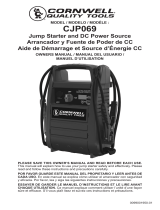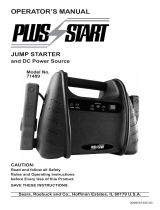
• 12 •
WARNING: RISK OF ELECTRIC SHOCK.
Incorrect operation of your converter may result in damage and personal injury. The converter output is
110V AC and can shock or electrocute the same as any ordinary household AC wall outlet.
110V AC ELECTRICAL DEVICE RUN-TIMES
APPLIANCE TYPE ESTIMATED WATTAGE ESTIMATED RUN TIME
Spotlights, sump pumps, DVD players
100 watts 1.5 hrs
Faxes, TVs, small power tools
150 watts 1.25 hrs
Computer printer, medium power tools, blenders
200 watts 55 min.
NOTE: These are estimated run-times, actual time may vary. Times are based on the internal battery
being new, fully charged and operated at room temperature.
NOTE: The maximum continuous load is 400 watts. Do not use the converter with a product that draws
more than 400 watts, as this may cause damage to the converter and the product.
6.7
Converter Shutdown Protection
The GREEN LED lights automatically when the converter is turned on. The RED LED will light and the
converter will shut down under the following conditions:
1. When the power input from the jump starter’s battery drops to approximately 10.5 volts, low battery
shutdown occurs and the converter shuts off. NOTE: At approximately 10.5 volts, the converter alarm
will sound, indicating the battery voltage is getting low. Solution: Recharge the jump starter.
2. When the power input from the jump starter’s battery exceeds 15 volts, high voltage overload protection
occurs. Solution: Reduce the voltage range of the battery to between 12 volts and 14 volts.
3. The continuous load demand from the equipment or device being operated exceeds the converter’s
400 watt capacity. Solution: Use a lower rated device.
4. The case temperature becomes hot (exceeds 145°F). Solution: Allow the converter to cool. Do not
block the cooling slots or air ow over and through the jump starter. Reduce the load on the converter
to the continuous rated output.
RESET: To reset after shutdown occurs, turn the converter OFF. Check the source of the problem and correct.
Turn the converter back ON.
7. MAINTENANCE INSTRUCTIONS
7.1
After use and before performing maintenance, unplug and disconnect the jump starter.
7.2
Use a dry cloth to wipe all battery corrosion and other dirt or oil from the battery clips, cords and the jump
starter case.
7.3
Ensure that all of the jump starter components are in place and in good working condition.
7.4
All servicing should be performed by qualied service personnel.
8. MOVING AND STORAGE INSTRUCTIONS
8.1
Store inside, in a cool, dry place.
8.2
Do not store the clips on the handle, clipped together, on or around metal, or clipped to cables. The clips
on the jump starter are live when the switch is in the ON position and will produce arcing or sparking if they
come in contact with each other. To prevent accidental arcing, always place the switch in the OFF position
and keep the clips on the storage holders when not using it to jump start a vehicle.
8.3
If the jump starter is moved around the shop or transported to another location, take care to avoid/prevent
damage to the cords, clips and jump starter. Failure to do so could result in personal injury or property damage.
IMPORTANT: Do not use and/or store the jump starter in or on any area or surface where damage could
occur if the internal battery should unexpectedly leak acid.
8.4
IMPORTANT:
• CHARGE IMMEDIATELY AFTER PURCHASE
• KEEP FULLY CHARGED
Charge the jump starter’s internal battery immediately after purchase, after every use and every 30 days.
All batteries are affected by temperature. The ideal storage temperature is at 70°F. The internal battery will
gradually self-discharge (lose power) over time, especially in warm environments. Leaving the battery in a
discharged state may result in permanent battery damage. To ensure satisfactory performance and avoid
permanent damage, charge the internal battery every month.



















